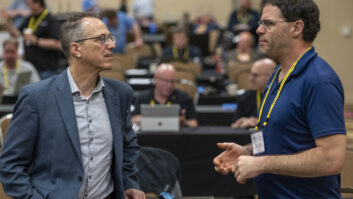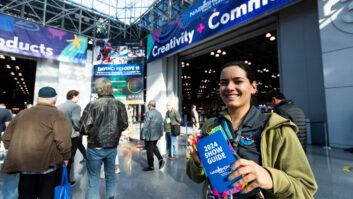NAB’s Broadcast Engineering Conference takes a practical turn this year, as the emphasis on Sunday’s daylong IBOC sessions turns from technology to implementation.
“In other years we’ve talked about system development,” said Milford Smith, vice president of engineering for Greater Media Inc. “We’ve talked about testing, we’ve talked about possible methods of implementation, those kind of issues. This year we’re really doing it.”
Smith will chair the morning IBOC sessions.
Jeff Littlejohn, vice president of engineering operations for Clear Channel Communications, who will chair the afternoon IBOC sessions, agrees.
Get it rolling
“In the past we talked about the technology, and this particular time we’re doing more talking about implementation and getting it rolling,” he said. “I would call it largely a nuts-and-bolts presentation.”
As an example, Littlejohn points to the presentation “Practical Considerations for the Implementation of AM IBOC” by Thomas Ray III, corporate director of engineering for Buckley Broadcasting/WOR Radio in New York.
“(He’s) doing a paper based on the testing that they did, and will talk about the troubles they had with implementation,” said Littlejohn.
Smith senses a lot of excitement about where IBOC is at this juncture.
“This really is a new radio service, that’s really what it is. The last time we had one of those was when FM showed up, and that was a long time ago. I think as we go about the practical implementation of this stuff, it’s a good idea to occasionally say, ‘Hey, this is a little bit of groundbreaking stuff here. This is something that will be with us for awhile.'”
The Broadcast Engineering Conference will kick off with a keynote from technologist Leonardo Chiariglione, vice president of Telecom Italia Lab, Torino, Italy. Chiariglione is founder and head of the MPEG committee since it was started in 1988.
Digital rights
“We’re especially excited about that keynote,” said Lynn Claudy, NAB senior vice president of science and technology. “This is the first time Leonardo Chiariglione has come to an NAB convention.” Claudy will chair the conference opening session.
Among the areas Chiariglione is expected to address is the timely issue of digital rights management.
“When the MP3 explosion occurred, and the record industry got worried because of the non-secure nature of MP3 and the ubiquity of the Internet, he was in charge of the standards effort to send compressed audio files across the Internet in a very secure way,” said Claudy.
The Secure Digital Music Initiative of which Chiariglione was in charge no longer exists. However, it began to bring together the music industry, distributors of music and users of music on the topic of copyright protection in the age of digital transmission.
“(Chiariglione) has a great perspective not only on how audio compression, and video compression for that matter, can be performed as a technical matter, but all the political and intellectual property questions that right now are really the crux of the discussions on compression and distribution of content,” Claudy said.
Kinstar
A Monday morning session on international developments includes some intriguing topics.
“Broadcast Engineering Behind the Lifted Iron Curtain” is presented by Martin Junek, presiden of the ABEX Society in Prague, Czech Republic. Another presentation delves into the Digital Radio Mondiale System, a third into networked systems in public broadcasting. Don Messer, chief of the Spectrum Management Division of the IBB, moderates.
Radio engineers likely will be drawn to two technical sessions on Tuesday, the Radio Transmission Forum in the morning and the Radio Audio Forum Tuesday afternoon.
Chairman for both sessions, Andy Laird, vice president of radio engineering for Journal Broadcast Group Inc., said the sessions are a combination of cutting-edge and practical papers. “Not only stuff that is new developments in RF and audio, but experience, case studies.”
Laird points to one paper that will be difficult for any AM engineer to pass up: “Testing and Results of a New, Efficient Low-Profile AM Medium Frequency Antenna System,” called the Kinstar, presented by Michael Jacobs, manager of research and development for Star-H Corp. Radio World reported on this project in the Jan. 1 issue.
“There have been many attempts to build a short-profile antenna for AM that is as efficient as a quarter-wave tower and has good bandwidth,” said Laird. “Nobody’s been able to achieve it, even thought there have been a number of attempts through the years. It looks like it has now happened.”
If the effort is successful, 350-foot towers could be replaced with 80-foot towers. “So the impact of this is huge,” he said. “It also appears that it will function in directional arrays where you’d have several towers, so this is a big one. They’ve been doing field tests … this will be kind of a progress report.”
OVERSEAS PRESENCE
The Tuesday sessions also have an international flavor, with presentations by engineers from HCJB World Radio, Quito, Ecuador; Audio Processing Technology, Belfast, Northern Ireland; and Coding Technologies, Nürnberg, Germany.
“We tried to integrate (overseas presenters) through the sessions,” said Laird. “This is an international convention by all measures of who attends.”
Wednesday’s Technology Luncheon features futurist and author George Gilder, chairman of Gilder Group Inc. His latest book, “Telecosm: How Infinite Bandwidth Will Revolutionize Our World,” explores the exponential growth in communications technology, supplanting computers as the engine of world economic growth. The NAB Engineering Achievement Awards will be presented at the lunch.
Wednesday also features an afternoon series on facility management, moderated by Troy Pennington. Among topics of interest to radio attendees are the new EIA-222-G standards for towers and structures; a novel method for detecting leaks on pressurized transmission systems by Hal Smith of AM/FM Services Co.; RF hazard control equipment by Richard Strickland of RF Safety Solutions; and designing for the unexpected, by George Crowe, about designing or adapting a building for broadcast use. He uses the BBC’s new Broadcasting House and White City developments as examples.
Wednesday night is the popular annual Amateur Radio Operators Reception.
Thursday morning will feature “Workbench Tips From Radio World’s John Bisset.” Bisset, an RF district sales manager for Harris Corp., will provide the practical discussion of maintenance, transmitters and transmitter sites that he brings to his column in this newspaper.
Claudy put a wrapper around the Broadcast Engineering Conference: “Technology is there to do it if they can find a proper way to fit it into their business plans. We’re going to hear a lot about that.”







